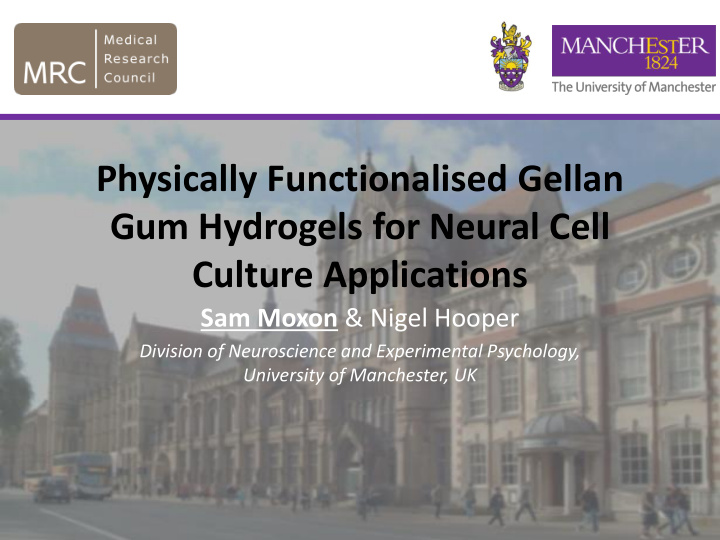



Physically Functionalised Gellan Gum Hydrogels for Neural Cell Culture Applications Sam Moxon & Nigel Hooper Division of Neuroscience and Experimental Psychology, University of Manchester, UK
Introduction • Dementia is now the leading cause of death in England and Wales • Consequently, research into probing the mechanisms behind dementia using neural cell culture is widespread • Progress has been made but is often limited by an inability to accurately model the disease in vitro as current methods often employ ‘classic’ 2D monolayer culture on plastic surfaces • Such strategies are high throughput but don’t allow for accurate replication of the soft, complex microenvironment in which neurodegenerative diseases progress • This can have a profound effect on cell behaviour and inhibit the ability to replicate disease pathologies and interrogate the underlying mechanisms
The Extracellular Matrix Focal Adhesion Site for Matrix Stiffness ‘Sensing’ Plasma Membrane Collagen Integrin-Matrix Binding Complex Gel-Forming Polysaccharides
Replicating the ECM in vitro • To overcome issues with monolayer culture, groups often culture cells using in vitro 3D cell niches • Hydrogels are popular tools for this application due to a high water content, low cytotoxicity and ability to replicate microstructural elements of native ECM • Many food hydrocolloids have been investigated for such applications (gellan gum, alginate, chitosan etc.) 100 µm Stenger et.al. (2001)
Collagen-Gellan Blended Hydrogels for Neural Culture • Brain ECM is mostly comprised of linear, unbranched, gel-forming polysaccharides • Fibrous proteins penetrate the polysaccharide network allowing for cell-matrix binding • Blended hydrogels of gellan gum and collagen are being investigated as a simple method to replicate this microenvironment
Collagen-Gellan Blended Hydrogels for Neural Culture Gellan Gum Collagen - Linear, unbranched - Fibrous, helical protein polysaccharide of bacterial found in native ECM origin - Contains cellular integrin - Capable of forming porous binding domains hydrogels through ionic - Could replicate the fibrous interactions element of brain ECM - Could replicate the responsible for cell polysaccharide network in attachment brain ECM Connery (2015) Osmalek et. al. (2014)
Fabrication of Blended Gels + Blend Loaded into Deposited Gel Mix Suspended Manufacture Syringe Blend Gellan Gum Collagen Hydrogel Blend Particulate Gel Support Matrix Add Cationic Solution to Extract Blended Incubate at 37°C to Trigger Crosslink Gellan Hydrogel Collagen Fibril Formation
Proof of Concept • As an initial proof of concept 3 hydrogel blends were prepared with varying gellan:collagen ratios (1:1, 2:1 and 4:1) • Both polymers were dispersed at a concentration of 0.5% w/w prior to blending • The final blends were suspended in particulate gel beds of 0.5% agarose • Frequency sweeps were conducted to determine the mechanical properties of each blend • SH-SY5Y neuroblastoma cells were also encapsulated in each blend and cultured for 21 days before a live/dead assay was used to determine cell viability and morphology
Rheology - The storage modulus of brain ECM is reported as being between 0.1 kPa and 1 kPa - All blends exhibited moduli within this range at low oscillatory frequencies 2500 Gellan Gum 4 to 1 2 to 1 1 to 1 2000 Storage Modulus (Pa) 1500 1000 500 0 0.1 1 10 Frequency (Rad/s)
Live/Dead Assay
Optimising the Microenvironment • Live/dead images suggested incorporation of collagen improved cell attachment, proving the concept of functionalising gellan with collagen fibres • However, cells seemed to adhere in clumps suggesting fibres did not penetrate ubiquitously through the gellan network • Perhaps gelation times were an issue?
Optimising the Microenvironment • 2:1 and 4:1 ratios of gellan and collagen were prepared suspended in particulate gel beds • Blends were then incubated at 37°C for 3 different time periods (1 hour, 3 hours and 6 hours) before addition of 100 mM CaCl 2 • This allowed the collagenous component to organise into fibrils for different lengths of time prior to gelation of gellan • Samples were then freeze-dried and analysed with SEM to analyse the resulting gel networks
SEM Results – 0.5% Gellan
SEM Results – 0.5% Collagen
SEM Results – 4:1 (Gellan:Collagen) 3 Hour Incubation 6 Hour Incubation 1 Hour Incubation 1 Hour Incubation 3 Hour Incubation 6 Hour Incubation
SEM Results – 2:1 (Gellan:Collagen) 3 Hour Incubation 6 Hour Incubation 1 Hour Incubation 1 Hour Incubation 3 Hour Incubation 6 Hour Incubation
Current Conclusions/On-Going Work • Blending 0.5% gellan with 0.5% collagen creates a soft matrix that can better reflect the mechanical properties of brain ECM. • Live/dead results suggests cells can adhere to blended gels but not to un- modified gellan. Further optimisation is required to achieve more uniform cell adhesion within the whole matrix. • SEM images could potentially demonstrate increasing incubation time prior to gellan crosslinking results in better formation of collagen fibrils within the matrix but this is difficult to quantify. • The proof may be in the cell behaviour with the effect of 1, 3 and 6 hour incubation on actin expression now being investigated. This could give us a more quantitative analysis of how cell adhesion can be optimised in the blended gels. • Once optimised, blended gels will be evaluated for neural cell culture using iPSC-derived neurons.
Acknowledgements ‘Team Hooper’ Dr Alan Smith Nicholas Pearman Jessica Senior James Rooney Dr Donald Dean Fund
Recommend
More recommend